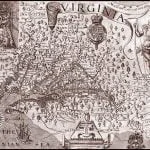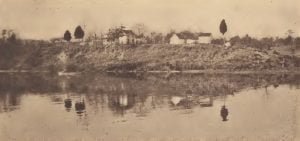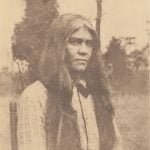One of the most important of the hitherto little known and unrecognized bands resides below Aylett’s landing, south of Mattaponi River, about a mile inland. The district is called Adamstown from the large number of the Adams family (fig. 20, a). They are citizens and have independent holdings near a large swamp which harbors considerable small game. On Captain John Smith’s map of 1612 their location corresponds correctly with a village marked on his chart as Passaunhick. Archeological surface surveys in the neighborhood evidence an extended and numerous original population and the Indian blood of the inhabitants, their Indian tradition of descent, and consciousness of their Powhatan affiliation, leave little room for doubt that this group of about 75 individuals exhibits what is left of the tribe belonging on the upper Mattaponi River. For this reason I have chosen, after consultation with Mooney and Chief Cook, to refer to them henceforth as the Upper Mattaponi band. It should be noted, however, that even the oldest among them know of no specific name ever being applied to them, save that of Adamstown Indians.

Even before the Civil War they were free. There is no remembrance of slavery, nor could we find any evidence of the people here having been “owned” during slave days, either in local records or among the old white inhabitants whose recollection extended back to ante-bellum days. There is little more that can be said concerning the history of this small group. Yet considerable folklore and fragmentary ethnological information remain to be harvested. During Mooney’s contact with the Powhatan enclaves he frequently had occasion to think of the Adamstown people, and in 1907 he noted their existence in the following terms, referring to the detached bands of Powhatan origin scattered through the tidewater counties:

What seems to be the largest of these, according to Pamunkey information, resides on Mattaponi River, about Aylett post office in upper King William County, the principal family names being Adams and Holmes. They are said to number about 40 in all, and to be in a very backward condition as compared with the Pamunkey, with whom they have little communication, although sometimes visiting the Mattapony. 1
Having been recognized for many years as Indians by the state school authorities, the Adamstown people have always been allowed a separate school. At present (1923) they are effecting an Indian organization like the other awakening Powhatan divisions. 2

Through Jasper Adams, one of their leaders, the following list of families is given as representing those considered eligible for membership in the organization. It represents their present numerical strength. Of a total number of 77 persons, more than three-fourths bear the name of Adams, other family names being Hincher, Mills, Dundjie, and Acree. They claim that formerly the Adams family had the name Holmes, that a white man named Adams, just before the Civil War period, settled with the band and gave his name and identity to most of the members. Joe Adams, who died in 1920, at an age of about 78, is thought to have been capable of pronouncing some native Indian words. This old man wore his hair long enough to reach his shoulders, one of the marks of identity in the region by which the Indian descendants distinguish them-selves from Negroes and mulattoes.
It might be added by way of a suggestion as to their original identity that the Adamstown tribe may represent descendants of the Nantaughtacund unit of Smith’s time, as Mooney thought of the Rappahannock, to whom the Adamstown people are partly related.
Citations:
- Mooney, James, The Powhatan Confederacy Past and Present, American Anthropologist, vol. ix, no. 1, 1907, p. 151.[
]
- Their organization was effected on July 4, 1923, with an enrollment of 77, under Jasper Adams as chief.[
]
